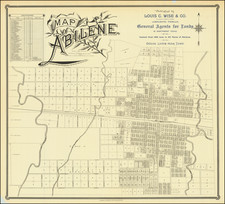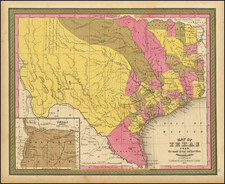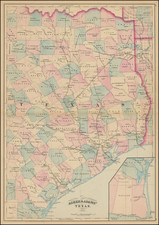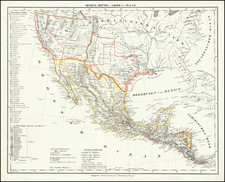One of the Earliest Obtainable Texas Views -- Champ D'Asile on the Trinity River
Rare aquatint of a romanticized scene at the Bonapartiste settlement of Champ d’Asile, published in Paris in 1817.
The image is one of two aquatint engravings of the Champ D'Asile showing the colonists dressed in elegant European attire, French soldiers in full military uniforms, the newest arrivals to the colony being welcomed with open arms, with additional colonists building Fort Charles and a home for General Rigaud on the Trinity River. The scene is set before an idealized set of mountains in the background.
Pinckney described the image as "Among the earliest and most significant prints depicting Texas in the very early years of its settlement [showcasing] Garneray’s precise and masterly designing [and] some of the best craftsmanship of the high period."
Kelsey located only about six earlier prints, with the only earlier 19th Century print being a portrait of Zebullon M. Pike from the 1810 edition of his book
The image was one of a number of engravings by French artist Garneray (1783-1837), which were published to raise funds to support the Champ d’Asile colony.
Champ d'Asile
Champ d'Asile a French Bonapartist settlement founded in Texas in January 1818. While nominally advertised as an agricultural colony, its strong military presence, the timing of its creation and largely military constituency suggested it may have had other designs.
The settlement was founded by French Bonapartist veterans of the Napoleonic Wars, who left the newly formed Bonapartist Vine and Olive Colony, which had been established in the summer of 1817. The group, led by General Charles Lallemand, established Champ d'Asile on land situated along the Trinity River, which was in turn abandoned in July of 1818.
The adverstised plan was to establish an agricultural settlement supported by a military presence, cultivating grapes and olives. Lallemand and his brother, Lieutenant-General Baron Henri-Dominique Lallemand financed the venture through land speculation. Over 100 French and foreign born military officers were part of the venture. On December 17, 1817, a group of 150 of the colonists sailed from Philadelphia for Galveston, Texas, arriving on January 14, 1818. After meeting with Lallemand and the other colonists at New Orleans, a group of about 120 volunteers left for Galveston on March 10, 1818, then sailing up the Trinity River to Atascosito where they built two small forts. After learning of the expedition, Mexican governor Antonio María Martínez sent his own troops to San Marcos and th colony was abandoned shortly afterwards.
The timing of the colonization effort was fraught with political intrigue. The colonists included pirate Jean Laffite and other mercenaries, which brought further concern. Champ d'Asile was founded at a time when disputes over territory were increasing, and shortly befor the signing of the Adams–Onís Treaty in 1819, at a time when control of the border was uncertain. In fact there was little evidence of agricultural work on the site, while construction of a fortress and manufacturing munitions had begun, suggesting less peaceful motivation.
Rarity
We note two examples of this print at auction in the past 70 years.
Mavis Parrott Kelsey, Charles J. Gross, Robin Brandt, Engraved Prints Of Texas, 1554-1900













![The North Coast of the Gulf of Mexico from St. Marks to Galveston . . . 1844 . . . Additions to 1856, including the Surveys of Comr. Powell, Lt. Simmes & Profr. Coffin, U.S. Navy [and] St. Marks to Galveston. Sheet II. . . . 1845. Additions to 1851 . . . .](https://storage.googleapis.com/raremaps/img/small/89497.jpg)
![(Dallas, Texas) USAF Target Complex Mosaic-Series 25 [Sheets 0 - 4]](https://storage.googleapis.com/raremaps/img/small/87119.jpg)